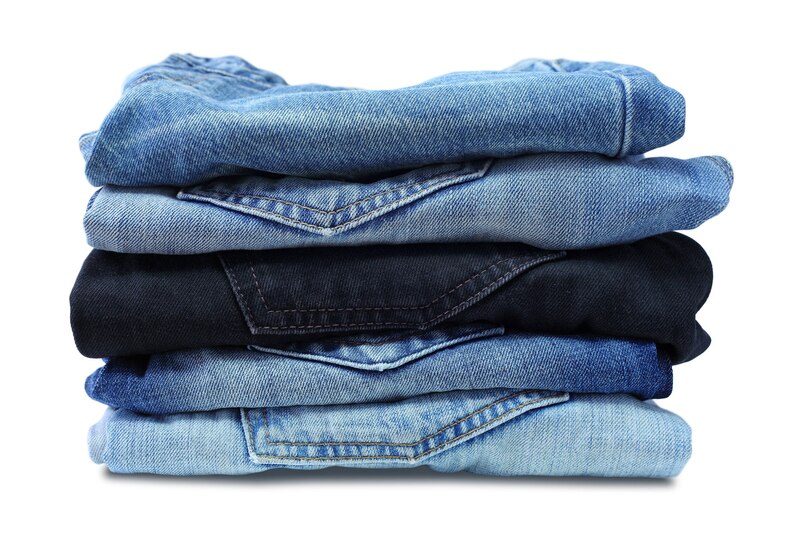Denim, the quintessential fabric of contemporary fashion, carries a rich and fascinating history that traces its roots from European workwear to a global style icon. Join us as we journey through time, exploring how denim evolved from a practical necessity to a symbol of rebellion and, ultimately, a timeless fashion staple.
The Roots of Denim: Workwear Beginnings
The Birth of Denim Fabric
Denim, the beloved fabric we know today, originates in the resilient cotton twills of Europe. The precursor to denim was a sturdy cotton twill known as “serge de Nîmes,” originating in the French city of Nîmes. This fabric featured a diagonal rib pattern and was favored for its durability. “denim” derives from “serge de Nîmes,” highlighting its French connection. However, the fabric’s journey to becoming denim as we recognize it was a transatlantic affair.
Levi Strauss and the First Jeans
The pivotal moment in denim history occurred in the late 1800s in the American West. Levi Strauss, a Bavarian immigrant, partnered with a tailor named Jacob Davis to patent a design that would forever change the course of denim fashion. They introduced riveted denim jeans, reinforcing stress points with metal rivets, making them incredibly robust for miners and laborers.
These “waist overalls,” as initially called, were an instant hit. The iconic Levi’s blue jeans, with their distinctive stitching and red tab, symbolized rugged individualism and the American frontier spirit.
Denim’s Role in Counterculture Movements
A. Denim in the Mid-20th Century
Denim’s popularity surged in the mid-20th century due to its association with rebellion. Icons like James Dean and Marlon Brando donned denim in their films, epitomizing the “bad boy” image. The fabric became synonymous with a carefree, anti-establishment attitude, capturing the hearts of young Americans. This era saw denim transition from workwear into casual wear, solidifying its place in everyday fashion.
The Hippie Era and Denim
The 1960s brought a different facet of denim to the forefront. The counterculture movement embraced denim, symbolizing peace, love, and a free-spirited lifestyle. It was worn by peace activists and artists who valued self-expression and non-conformity. Bell-bottom jeans and denim vests became staples of the era, embodying the rejection of societal norms.
Denim as High Fashion
The Designer Denim Revolution
Denim underwent a remarkable transformation during the 1970s and 1980s, evolving from workwear and casual attire into a luxury fashion item. Designers like Calvin Klein and Gloria Vanderbilt were pivotal in this shift. High-end denim brands emerged, offering meticulously crafted jeans with designer labels. Denim was no longer just a practical choice but a statement of style and status.
Denim on the Runway
Denim’s journey through the world of high fashion continues. Renowned designers regularly incorporate denim into their collections. This fabric’s versatility makes it a recurring star on the runway, from denim skirts and dresses to tailored denim blazers. Denim’s presence in haute couture demonstrates its enduring appeal and adaptability.
Sustainable Denim: A Modern Movement
Eco-Friendly Denim Production
The denim industry is adopting more sustainable practices in response to growing environmental concerns. This includes using organic cotton, reducing water usage, and implementing eco-friendly dyeing techniques. These changes are crucial for minimizing the environmental impact of denim production.
Vintage and Upcycled Denim
The appeal of vintage and upcycled denim is on the rise. Many individuals and brands are breathing new life into old jeans by repurposing them into unique pieces. This trend reflects a growing interest in conscious consumerism and the desire for clothing with character and history.
Denim in Contemporary Culture
Denim’s Role in Pop Culture
Denim remains a significant presence in pop culture. Musicians, actors, and celebrities frequently choose denim as their go-to style. From denim jackets worn by rock legends to denim shorts in music videos, it continues influencing music, film, and celebrity fashion choices.
The Versatility of Denim
Denim’s versatility is unrivaled. It transitions from casual wear, like jeans and T-shirts, to chic and sophisticated ensembles. Whether dressing up for a formal event or seeking comfort in everyday life, denim offers a broad spectrum of options.
How did denim became associated with rebellion in the mid-20th century?
Denim’s association with rebellion can be traced back to Hollywood icons like James Dean and Marlon Brando, who wore denim in films that depicted anti-establishment and “bad boy” characters. This portrayal cemented denim as a symbol of defiance and non-conformity.
What are some sustainable practices in denim production?
Sustainable denim production includes using organic cotton to reduce pesticide use, implementing water-saving techniques, and using eco-friendly dyes. These practices aim to minimize the eco-friendly impact of denim manufacturing.
Why is vintage and upcycled denim gaining popularity?
Vintage and upcycled denim appeal to those seeking unique, unique, unique pieces with character. It aligns with conscious consumerism, where people value clothing that tells a story and promotes sustainability by reducing waste.
How has denim’s role in pop culture evolved over the years?
Denim remains a prominent feature in pop culture. It’s worn by musicians, actors, and celebrities in various forms, from denim jackets to jeans. Its enduring presence in pop culture reflects its timeless and versatile appeal.
What makes denim so versatile?
Denim’s versatility lies in its adaptability to different styles and occasions. It can be dressed up or down, making it suitable for casual wear, formal events, or everyday comfort. Its enduring rage is a testament to its adaptability.
Conclusion
Denim’s journey from humble workwear to a timeless fashion staple has been marked by its evolution and adaptability. From its workwear beginnings in Europe to its iconic status in American culture, denim has transcended its origins. It has been a symbol of rebellion, a canvas for self-expression, and a canvas for designers’ creativity. In the modern era, it’s a fashion statement and a driver of sustainable practices. Denim continues to be a versatile fabric that thrives in contemporary culture, offering something for everyone. Its enduring appeal is a testament to its place in the annals of fashion history.


